Perennial gardens are a fantastic way to create lasting beauty in your outdoor space, offering a burst of color and texture year after year. With a bit of creativity and some inspiring ideas, you can design a garden that thrives through every season. Let’s jump into a variety of perennial garden design concepts that will surely ignite your imagination and bring your garden to life!
Shade-Tolerant Perennial Arrangements
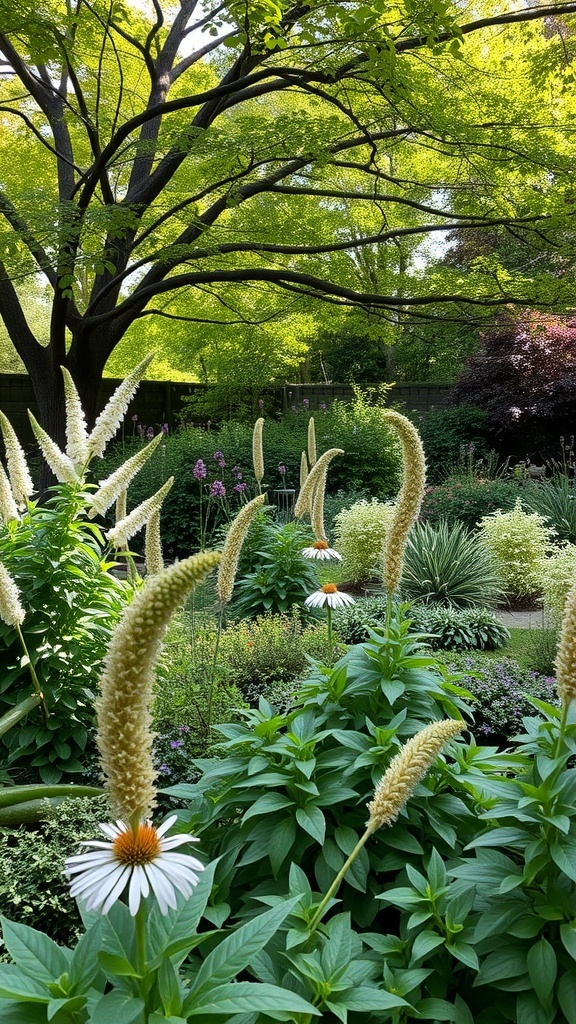
Creating a beautiful garden in shaded areas can be a rewarding experience. The image shows a lush garden filled with various perennials that thrive in low light. The tall, feathery plants add height and texture, while the cheerful white flowers bring a pop of brightness.
When designing a shade garden, consider using a mix of plants that bloom at different times. This ensures that your garden remains vibrant throughout the seasons. The green foliage in the background complements the flowers and creates a serene atmosphere.
Incorporating plants like hostas, ferns, and astilbes can enhance the visual appeal. These plants not only tolerate shade but also add diversity to your garden. Layering the plants with taller varieties in the back and shorter ones in the front creates depth and interest.
Don’t forget to add some decorative elements like stones or garden art to make the space feel inviting. A well-planned shade garden can become a peaceful retreat, perfect for enjoying nature’s beauty.
Perennial Borders for Structure and Flow
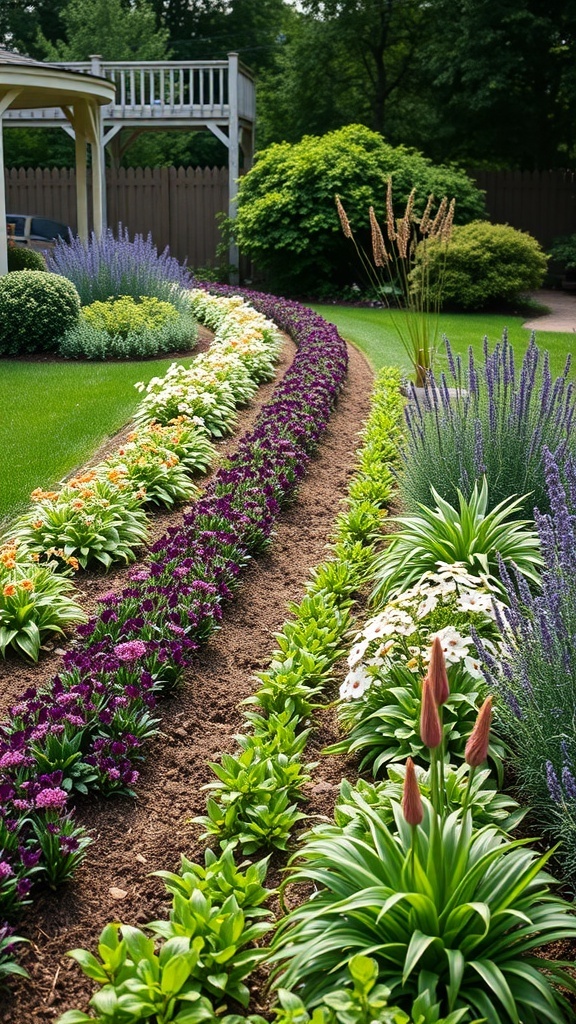
Creating perennial borders is a fantastic way to add structure and flow to your garden. The image shows a beautifully arranged border filled with vibrant flowers and lush greenery. This design not only enhances the visual appeal but also guides the eye through the garden.
Notice how the different colors and textures of the plants work together. The purple flowers contrast nicely with the white and green, creating a lively scene. This mix of perennials ensures that there is something blooming at different times, keeping your garden looking fresh throughout the seasons.
When planning your borders, think about the height of the plants. Taller varieties at the back and shorter ones in front create depth. This layering effect can make even a small garden feel more expansive. Plus, it helps to highlight each plant’s unique beauty.
Don’t forget to consider the maintenance of your perennial borders. Choosing plants that thrive in your local climate will make your garden easier to care for. With a little planning, you can enjoy a stunning display that requires minimal effort.
Textural Variety with Foliage and Blooms
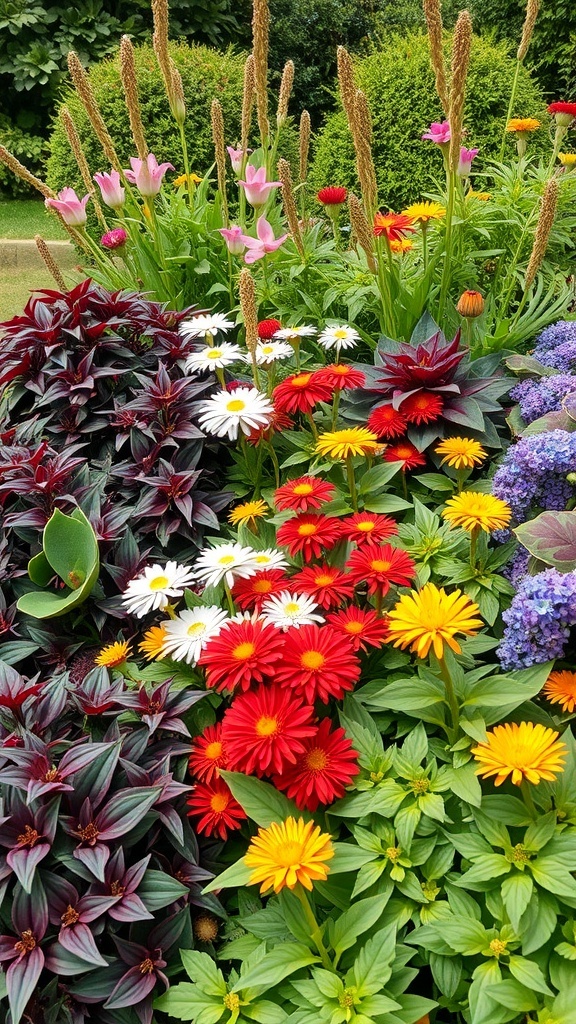
Creating a perennial garden is all about mixing different textures and colors. The image showcases a vibrant arrangement of flowers and foliage that brings life to any space. You can see a delightful mix of reds, yellows, and whites, which instantly catch the eye.
The bold red and yellow blooms stand out against the dark, rich foliage of the surrounding plants. This contrast not only adds depth but also creates a lively atmosphere. The tall, feathery spikes in the background provide height and movement, enhancing the overall visual appeal.
Incorporating various shapes and sizes of plants is key to achieving a dynamic look. Notice how the round leaves and spiky flowers work together harmoniously. This blend of textures makes the garden feel full and inviting.
To achieve a similar effect in your own garden, think about mixing different types of plants. Combine low-growing flowers with taller varieties to create layers. Don’t shy away from using plants with unique leaf shapes, as they can add interest even when not in bloom. With a little planning, you can create a stunning perennial garden that showcases both foliage and flowers beautifully.
Layered Planting for Year-Round Interest
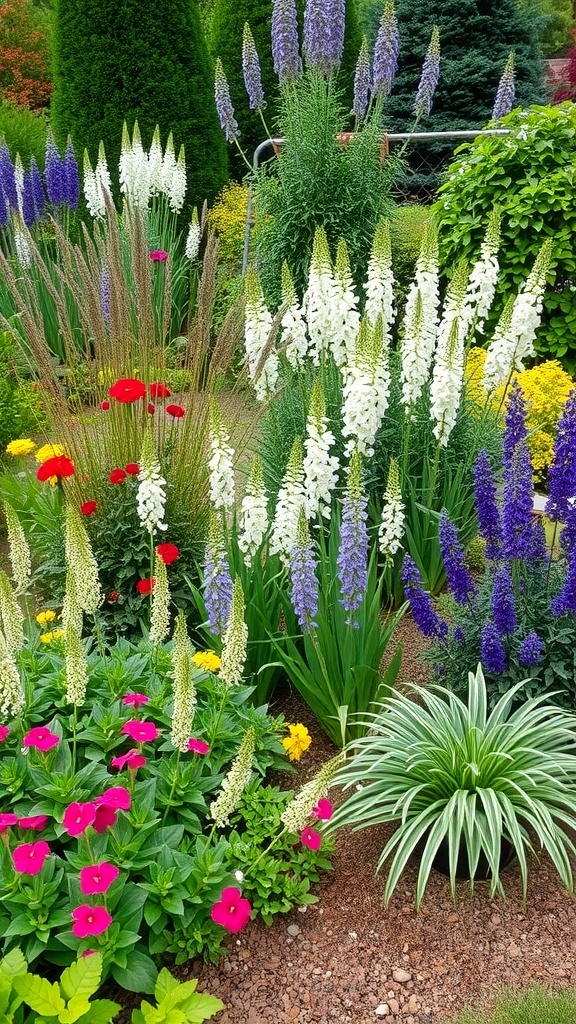
Layered planting is a fantastic way to create a garden that looks beautiful throughout the year. The image showcases a vibrant mix of flowers and foliage, demonstrating how different heights and colors can work together. The tall, spiky flowers in shades of blue and white stand proudly, while the lower plants in bright pink and yellow add a cheerful touch.
Incorporating various plant types is key. For instance, the tall plants provide a backdrop, while the shorter ones fill in the foreground. This layering not only adds depth but also ensures that there’s always something in bloom. The combination of textures and colors keeps the garden lively and inviting.
Think about the seasons too. Choose some perennials that bloom in spring, while others may shine in summer or fall. This way, your garden remains interesting no matter the time of year. The image perfectly illustrates how a well-planned layered garden can be a feast for the eyes, making it a lovely spot to relax or entertain.
Low-Maintenance Perennial Combinations
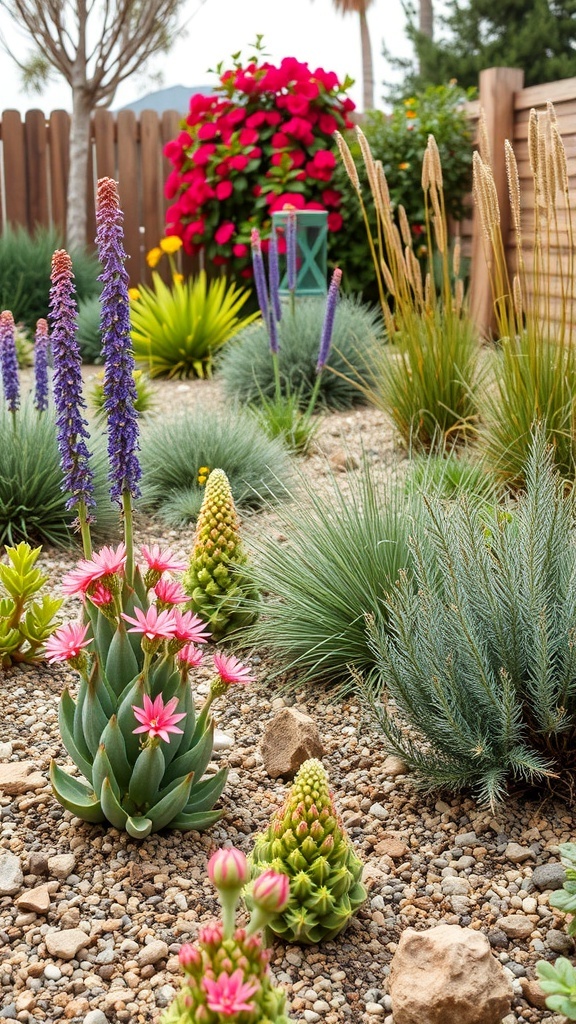
Creating a low-maintenance perennial garden can be a rewarding experience. The image showcases a vibrant mix of plants that thrive with minimal care. The colorful blooms and varied textures bring life to the space, making it visually appealing without demanding too much attention.
In the foreground, you see striking pink flowers that add a pop of color. These are paired with unique succulent shapes that provide interest throughout the year. The combination of different plant heights creates a layered look, which is both attractive and functional.
In the background, the lush bougainvillea stands out, offering a beautiful contrast to the more subdued greens and blues of the other plants. This combination not only looks great but also helps to attract pollinators, enhancing the garden’s ecosystem.
Using drought-tolerant plants like those in the image can save time and resources. They require less watering and are often more resilient to pests. This makes them perfect for busy gardeners who still want a beautiful outdoor space.
Overall, this garden design is a great example of how to mix colors and textures for a low-maintenance yet stunning perennial garden. It’s a perfect inspiration for anyone looking to simplify their gardening routine while still enjoying a vibrant landscape.
Cottage Garden Charm with Perennials
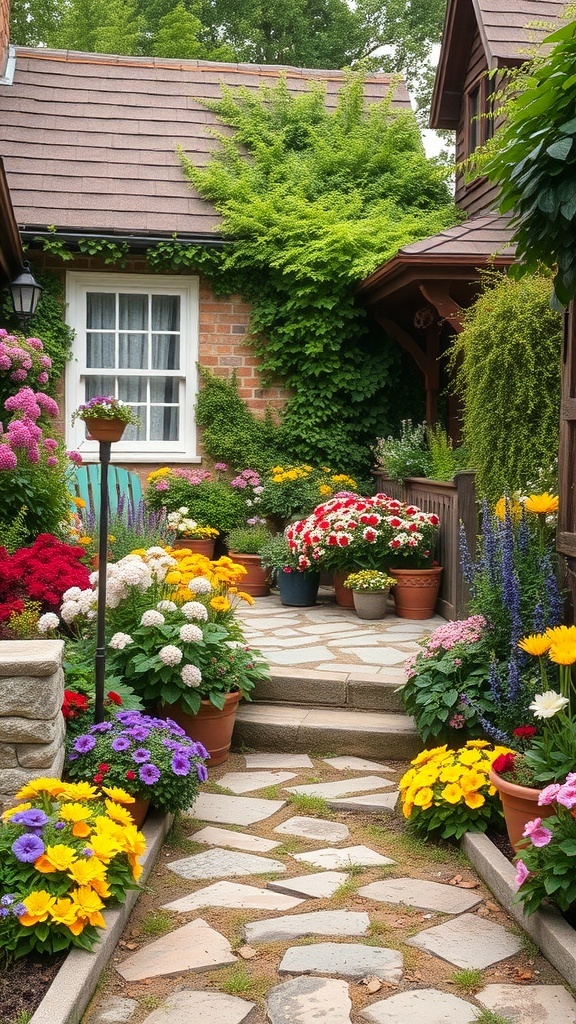
Cottage gardens are known for their cozy, inviting feel, and using perennials is a fantastic way to achieve this charm. The image showcases a delightful pathway lined with colorful flowers in pots, creating a warm and welcoming atmosphere.
The vibrant reds, yellows, and purples of the flowers contrast beautifully with the earthy tones of the stone path. This combination adds a touch of whimsy and makes the garden feel alive. Perennials are perfect for this style, as they come back year after year, providing consistent beauty with minimal effort.
Notice how the lush greenery climbs the walls, softening the edges and enhancing the cottage look. Incorporating climbing plants can add height and texture, making the space feel more layered and inviting. The mix of potted plants along the path not only adds color but also allows for easy rearrangement and seasonal updates.
Creating a cottage garden with perennials means you can enjoy the blooms without the hassle of replanting each year. This design invites you to stroll through, take in the scents, and enjoy the beauty of nature right at your doorstep.
Seasonal Color Schemes in Perennial Design

Creating a perennial garden is all about embracing the beauty of seasonal color. The image showcases a vibrant mix of flowers that bloom in various hues, bringing life to any outdoor space. The bright yellows, rich purples, and warm oranges create a cheerful atmosphere, perfect for enjoying sunny days.
When planning your garden, think about how colors change with the seasons. In spring, you might want to incorporate softer pastels, while summer can be filled with bold, bright colors like those seen in the image. This not only enhances the visual appeal but also keeps your garden lively throughout the year.
Combining different flower types, like the cheerful daisies and striking lilies shown, can create a stunning display. Layering plants with varying heights adds depth and interest. Consider how these colors will interact with each other and the surrounding landscape.
Don’t forget to include some greenery to balance the bright blooms. Foliage can provide a backdrop that makes the colors pop even more. With thoughtful planning, your perennial garden can be a beautiful canvas that changes with the seasons, offering something new to admire all year long.
Pollinator-Friendly Perennial Beds
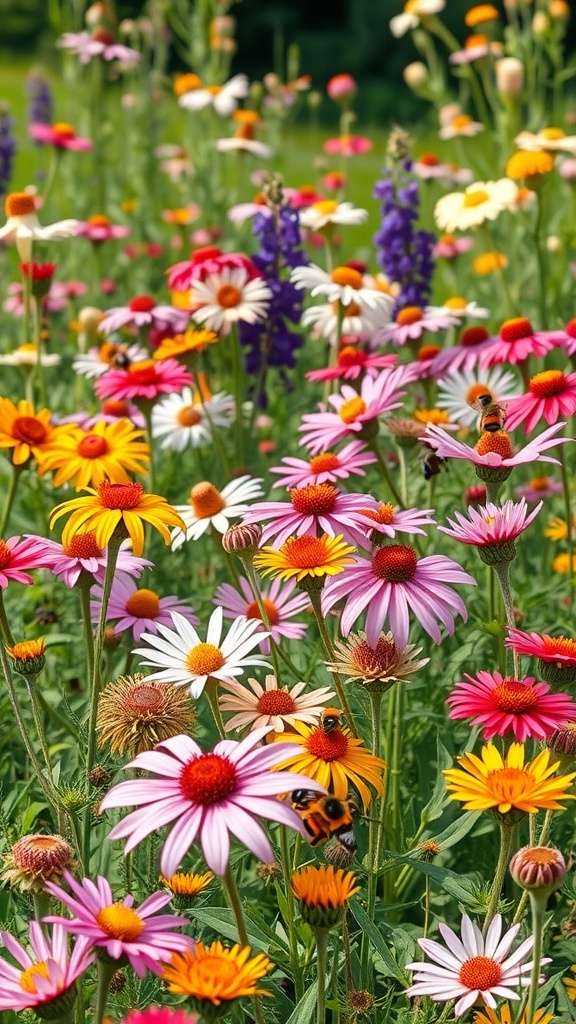
Creating a pollinator-friendly perennial bed is a fantastic way to support local wildlife while adding beauty to your garden. The image showcases a vibrant mix of flowers, including daisies and coneflowers, which are known to attract bees and butterflies. These colorful blooms not only brighten up the landscape but also provide essential nectar and pollen for pollinators.
When planning your perennial bed, consider choosing a variety of plants that bloom at different times throughout the growing season. This ensures that there is always something in bloom for the pollinators. For instance, early bloomers like crocuses can provide food in spring, while late bloomers like asters can support pollinators into the fall.
Incorporating native plants is another great idea. Native species are often better suited to your local climate and soil conditions, making them easier to care for. Plus, they tend to attract more local pollinators. Don’t forget to leave some areas of your garden a bit wild; this can create habitats for beneficial insects.
Lastly, consider adding features like small water sources or rocks for basking. These elements can make your garden even more inviting for pollinators. With a little planning, your perennial bed can become a thriving ecosystem that supports both plants and wildlife.
Vertical Gardening with Perennials
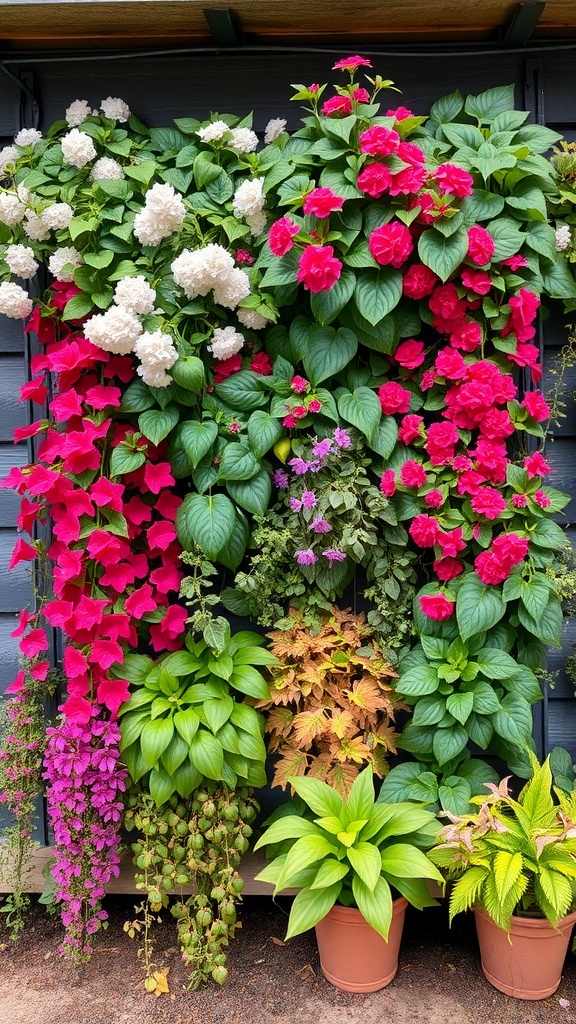
Vertical gardening is a fantastic way to maximize space while adding beauty to your garden. The image showcases a stunning display of colorful perennials climbing up a wall, creating a vibrant and lush atmosphere.
In this setup, various plants like hydrangeas, impatiens, and other flowering species come together, offering a feast for the eyes. The mix of colors, from bright pinks to soft whites, creates a lively backdrop that can brighten any outdoor area.
Using vertical space allows you to enjoy gardening even in small areas. You can incorporate trellises, wall planters, or hanging pots to achieve this look. This not only saves ground space but also adds dimension to your garden.
Consider choosing perennials that bloom at different times to ensure your vertical garden remains lively throughout the seasons. This way, you can enjoy a continuous display of color and texture, making your garden a delightful retreat.
Edible Perennials for Sustainable Gardening
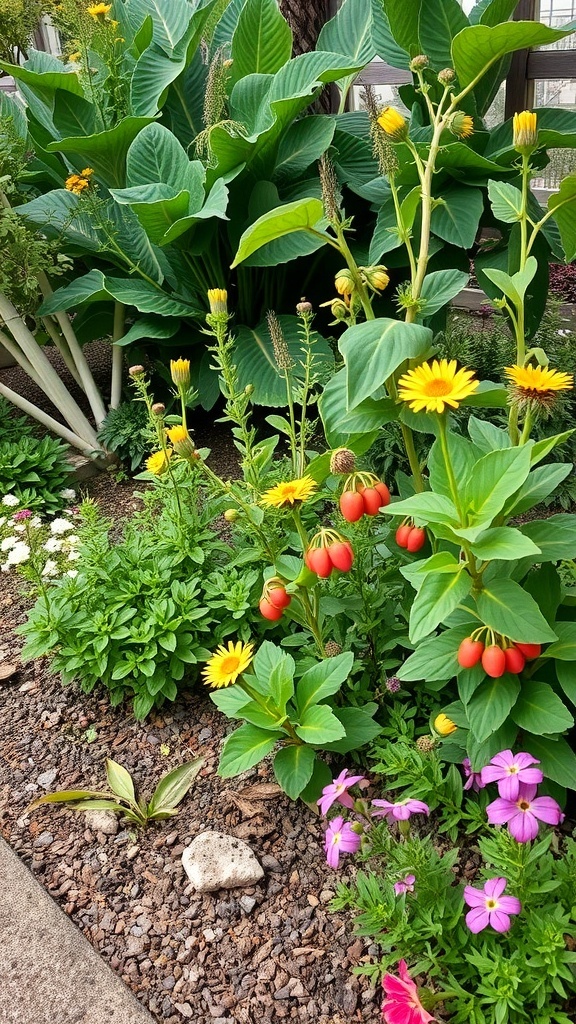
Creating a garden that is both beautiful and functional is a rewarding experience. The image showcases a vibrant mix of edible perennials and ornamental plants. You can see bright yellow flowers, lush green leaves, and even some red fruits peeking through. This blend not only adds color but also provides delicious options for your kitchen.
Edible perennials like the ones in the image can thrive year after year. They require less maintenance compared to annuals, making them perfect for sustainable gardening. Imagine walking through your garden and picking fresh herbs or fruits whenever you need them!
Some great choices for your garden include rhubarb, asparagus, and various herbs like mint and thyme. These plants not only taste great but also attract beneficial insects, helping your garden flourish. Pair them with colorful flowers for a stunning visual appeal.
Incorporating edible perennials into your garden design can lead to a more sustainable lifestyle. You’ll enjoy fresh produce while also contributing to a healthier environment. So, why not start planning your own edible perennial garden today?
